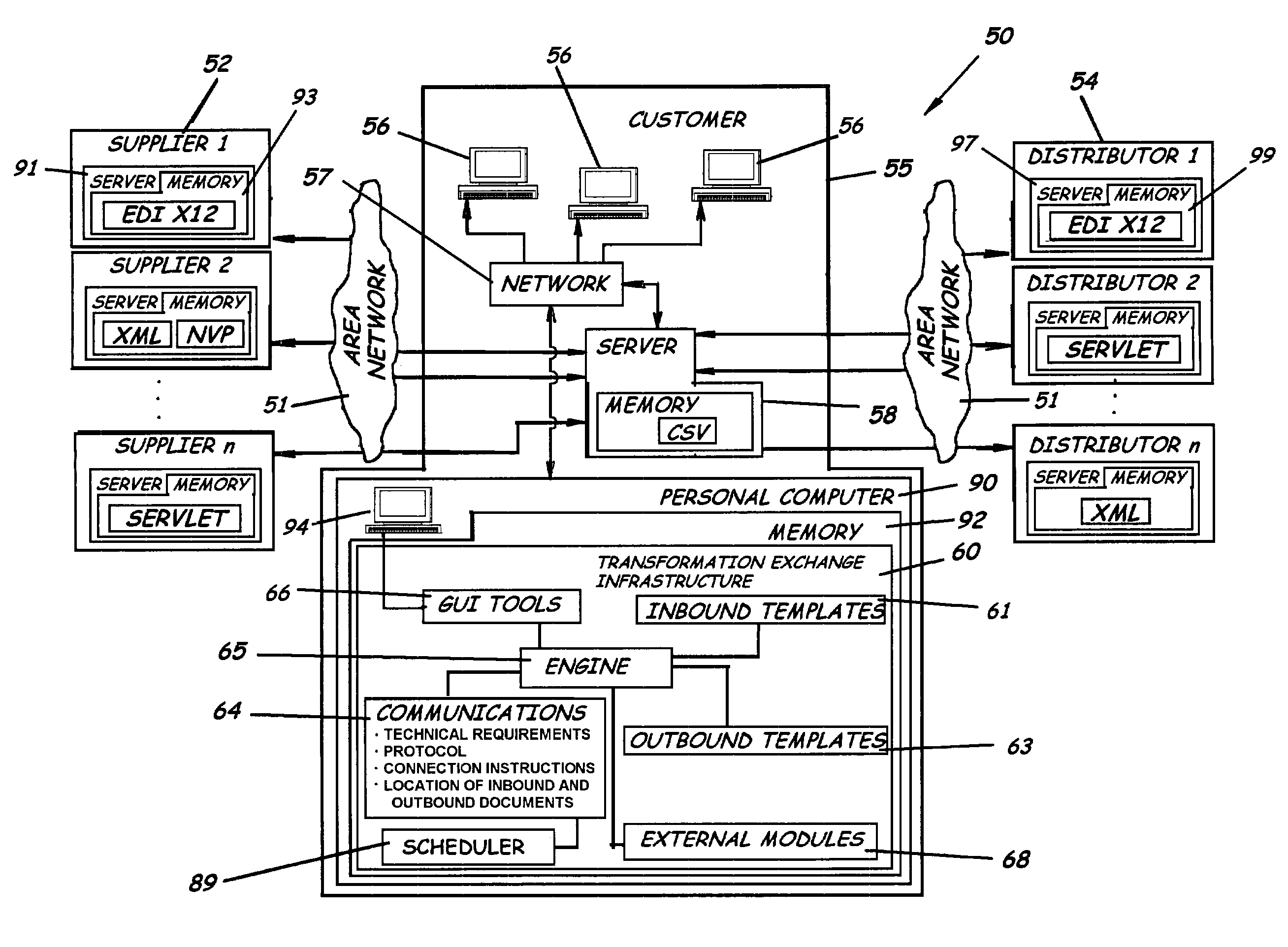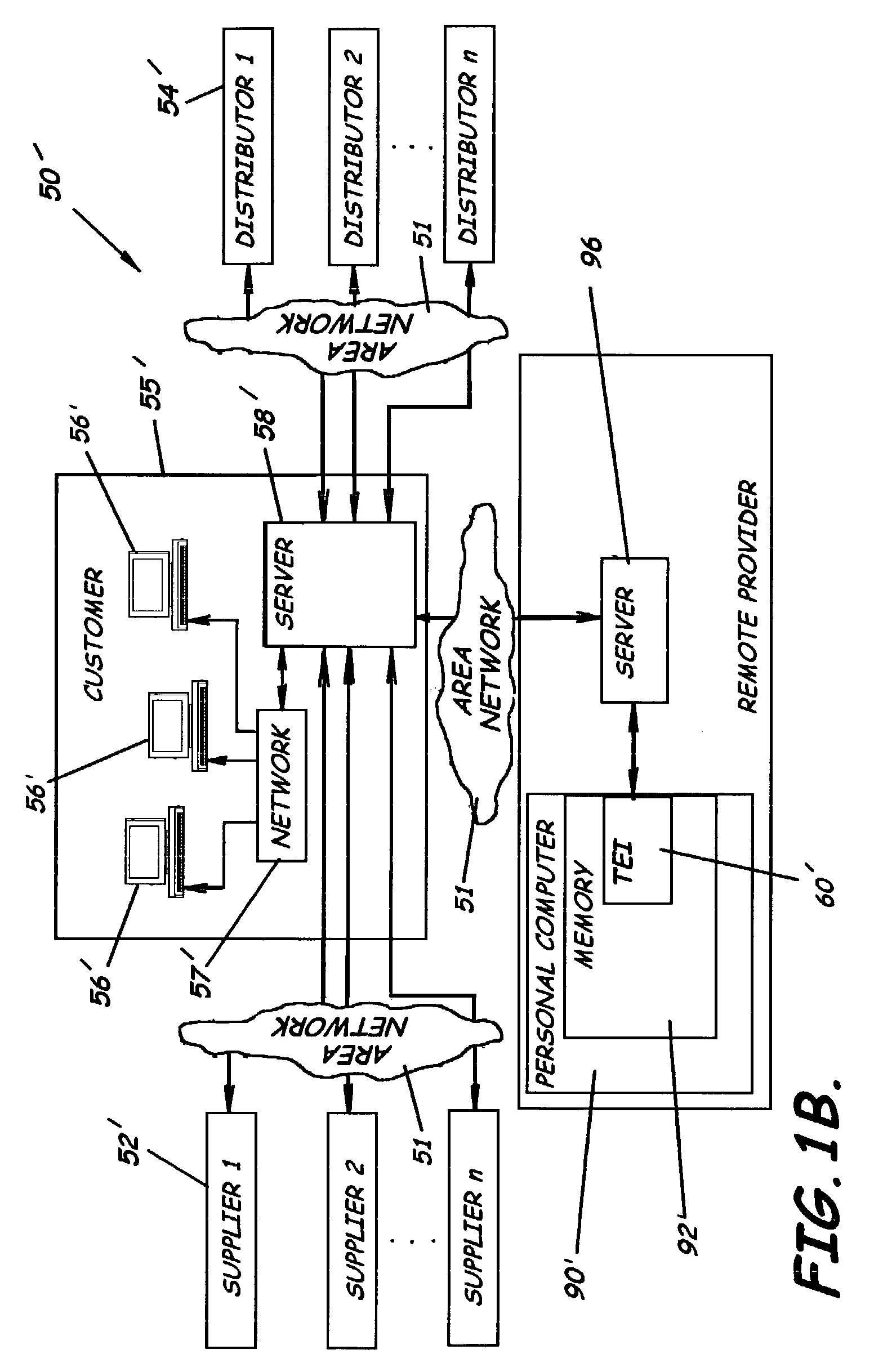[0010]In view of the foregoing, embodiments of the present invention advantageously provide a
system, software, and methods for data connectivity and integration that facilitate fast and accurate transformation and exchange of data among a plurality of entities, sources, or applications. Embodiments of a
system, software and methods for data connectivity and integration of the present invention advantageously identify a communication
data format or connectivity protocol and translate or transform it to its connected applications. Embodiments of a system and software for data connectivity and integration of the present invention are also adaptable to predictable future formats that may come into practice, and can perform these functions in near real-time. Because embodiments of a system and software for data connectivity and integration of the present invention operate as a translator, these embodiments do not rely on a limited set of pre-determined modules. Embodiments of a system, software and methods for data connectivity and integration of the present invention further advantageously adapts easily to a very large number of entities, sources, or applications and, therefore, require little time or investment to implement. Embodiments of a system, software, and methods for data connectivity and integration of the present invention still further advantageously were developed as a powerful, open approach to data connectivity and leverage the capabilities of existing standards, such as EDI,
XML and
Java, to manipulate, transform, and exchange
electronic data transparently and accurately.
[0017]More particularly, embodiments of the present invention provides a system for data connectivity and integration that includes a first computer defining a first
server. The first
server has a first memory, a first data set stored therein, and a first data interchange protocol. A first
area network is in communication with the
server, and a plurality of remote data terminals is in communication with the first server through the first
area network by the first data interchange protocol. At least one remote
data terminal of the plurality of remote data terminals has
data terminal memory associated therewith. A second
area network is in communication with the first server and the at least one remote
data terminal. A second computer remote from the first server is in communication with the second area network and defines a second server. The second server has a second memory, a second data set stored therein, and a second data interchange protocol. A third computer remote from the first server is in communication with the second area network and defines a third server. The third server also has memory, a third data set stored therein, and a third data interchange protocol. Transformation and exchange gateway software can be stored in the data terminal memory of the at least one data terminal of the plurality of remote data terminals, has an output in communication with the first server through the first area network by the first data interchange protocol, and has an input in communication with the second server through the second area network by the second data interchange protocol and in communication with the third server through the second area network by the third data interchange protocol to transform each of the second and third data interchange protocols to the first data interchange protocol so that the respective second and third data sets can be effectively communicated to the first server through the transformation and exchange gateway software and be in the first data interchange protocol for effective use by the plurality of remote terminals and to transform the first data interchange protocol to the respective second and third data interchange protocols so that first data set can be communicated from the first server to the second and third servers for effective use thereby.
[0021]Embodiments of a system, methods, and software for data connectivity and integration of the present invention have a
data transformation and exchange engine capable of interpreting templates that describe the incoming and / or outgoing data without actually carrying the data. This, for example, releases embodiments of a system, software, and methods from having to “know” anything about any other data standards or formats. Instead, these embodiments act as a sort of universal translator. This universal translator can receive data transmitted from essentially any source and transform it, according to the instructions found in the interpreting templates, into the format needed by or understood natively by a receiving destination entity or source. By providing embodiments of a system, methods, and software for data connectivity and integration of the present invention, for example, entities are no longer forced to fit their data into existing “standards” and enhances these entities abilities to do business with other entities for which they otherwise were not able.
[0023]Implementation of embodiments of TEI gateway software of the present invention advantageously can use layered architecture to allow the software to be embedded inside another application, used as an
application service provider (ASP), run as a stand-alone application, or implemented as separate independent modules. The software can operate in the
enterprise application integration (EAI) space because it is capable of connecting disparate systems together in a unifying manner, but is different from traditional EAI tools in that it does not require “deep” integration into
customer relationship management (“CRM”),
enterprise resource planning (“ERP”), or other enterprise applications in order to achieve the goal of system
interoperability. For example, if the goal is to capture customer data using a CRM application, and then make sure that the customer's relevant billing information is transferred into the backend ERP system, the TEI gateway software easily handles this without requiring that the CRM and ERP systems be awkwardly united. Instead, these systems can remain separate systems without requiring that the TEI gateway software be surgically (and artificially) implanted.
 Login to View More
Login to View More  Login to View More
Login to View More 


